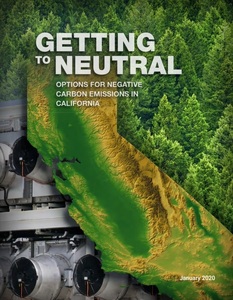A new report released by Lawrence Livermore National Laboratory has determined California can achieve its goal of carbon neutrality by 2045 at modest cost using technology that is already demonstrated and mature, including carbon capture from waste biomass utilization.
California Executive Order B-55-18 was signed by Gov. Jerry Brown in September 2018. It sets a statewide goal to achieve carbon neutrality as soon as possible, and no later than 2045, and maintain net negative emissions thereafter.
LLNL announced the results of a new study on Jan. 30 that determined that goal is feasible. That study, titled “Getting to Neutral: Options for Negative Carbon Emissions in California,” identified a robust suite of technologies that can allow the state to become carbon negative by 2045. According to LLNL, its report details a thorough assessment of the advanced
carbon reduction technologies now available, their costs, as well as the tradeoffs necessary to reach the state’s decarbonization goal.
“Our findings give us confidence that this combination of negative emissions technologies and the state’s existing ambitions put the finish line in reach for California,” said Roger Aines, LLNL’s Energy Program chief scientist and the lead on the project. “The report’s findings also indicate we could become carbon neutral sooner than anticipated, at a cost less than expected, while boosting California’s economy and creating quality jobs in areas such as the Central Valley. Important co-benefits to air quality and wildfire prevention also will bring welcome relief to our state.”
The report focused on three pillars of negative emissions: natural and working lands, carbon capture from waste biomass utilization, and direct air capture. According to LLNL, the team identified a portfolio of approaches for achieving greater than 125 million tons per year of negative emissions for California by 2045 and evaluated the scope of state and private investment to best achieve the goal.
Within the report, LLNL notes that the 125 million ton per year goal can be met by increasing the uptake of carbon in natural and working lands, converting waste biomass into fuels, and removing carbon dioxide directly from the atmosphere with purpose-built machines. The researchers say the goal can be achieved at a cost of less than $10 billion per year, which equates to less than 0.4 percent of the state’s current gross domestic product. To achieve the goal, however, LLNL notes that concerted efforts are required to broaden uptake of new land management practices, establish infrastructure, including waste biomass processing plants, to produce carbon-negative fuels, and pipelines to transport carbon dioxide to underground permanent storage sites.
Regarding waste biomass, the report notes that approximately 56 million bone dry tons per year are available across the state from trash, agricultural waste, sewage and manure, logging and fire prevention activities. Much of that biomass currently returns its carbon to the atmosphere when it decays or is burned. “Converting this biomass into fuels with simultaneous capture of the process [carbon dioxide] emissions holds the greatest potential for negative missions in the state,” the authors said in the report. “A broad array of processing options is available, and includes collecting biogas from landfills, diaries, and wastewater treatment plants for upgrading to pipeline renewable natural gas; conversion of woody biomass to liquid fuels and biochar through pyrolysis; and conversion of wood biomass to gaseous fuels through gasification.” According to the report, the gasification of biomass to make hydrogen fuel and carbon dioxide has the largest promise for carbon dioxide removal at the lowest cost.
A full copy of the report can be downloaded from the LLNL website.
Source : http://biomassmagazine.com/

